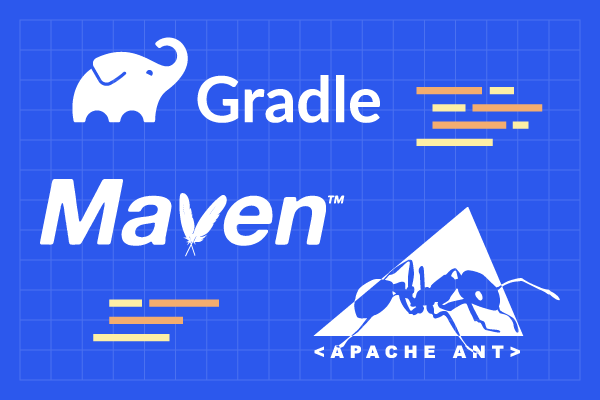Maven vs. Gradle vs. Ant: A Comparison of Build Tools for Java
In the world of Java development, build tools play a crucial role in automating and managing the build lifecycle of projects. Three prominent build tools that have gained immense popularity over the years are Maven, Gradle, and Ant. Each of these tools offers a unique approach to managing dependencies, compiling code, and creating executable artifacts. In this blog post, we’ll dive into a comprehensive comparison of Maven, Gradle, and Ant to help you make an informed decision about which tool suits your project’s needs.
Maven: The Convention-Based Build Tool
Maven is one of the oldest and most widely used build tools for Java projects. It follows the principle of convention over configuration, providing a structured and standardized way of organizing projects. With Maven, you define your project’s configuration in an XML file called “pom.xml” (Project Object Model). This XML file includes project information, dependencies, plugins, and build settings.
Pros of Maven:
- Conventions: Maven enforces a predefined project structure, making it easier for developers to understand and navigate projects.
- Centralized Repository: Maven Central Repository hosts a vast collection of open-source Java libraries, making dependency management seamless.
- Plugin Ecosystem: Maven boasts a rich ecosystem of plugins that cater to various build tasks, such as compiling code, running tests, generating reports, and more.
- Dependency Management: Maven simplifies dependency management by automatically resolving and downloading project dependencies.
Cons of Maven:
- Rigidity: While its conventions are beneficial, Maven’s rigid structure might not fit well with complex or non-standard project setups.
- Verbosity: Maven’s XML configuration can become verbose for larger projects, making the “pom.xml” file lengthy and harder to manage.
Gradle: The Flexible Build Automation Tool
Gradle is a modern build tool that combines the best of both worlds – the convention-based approach of Maven and the flexibility of Ant. It uses a Groovy-based DSL (Domain-Specific Language) for defining project configurations and tasks. Gradle’s focus on “build by convention, configure by code” philosophy allows developers to tailor the build process to their specific requirements.
Pros of Gradle:
- Flexibility: Gradle’s powerful DSL enables developers to create custom build logic and configurations, making it suitable for projects of all sizes and complexities.
- Incremental Builds: Gradle’s incremental build feature speeds up build times by only compiling and processing the changed parts of the project.
- Dependency Management: Like Maven, Gradle simplifies dependency management and supports both local and remote repositories.
- Plugin System: Gradle’s plugin ecosystem allows seamless integration of various build tasks and functionalities.
Cons of Gradle:
- Learning Curve: The flexibility of Gradle comes with a steeper learning curve, especially for newcomers to build tools.
- Complexity: For small projects with straightforward requirements, the added flexibility might be overkill and lead to unnecessary complexity.
Ant: The OG Build Tool
Apache Ant is one of the oldest Java build tools, known for its flexibility and simplicity. Unlike Maven and Gradle, Ant doesn’t impose a specific project structure or conventions. Instead, developers define tasks in XML files, specifying how the build process should be carried out.
Pros of Ant:
- Flexibility: Ant offers complete control over the build process, making it suitable for projects with unique requirements.
- Simplicity: Ant’s XML configuration is straightforward and easy to understand, making it a good choice for simple projects.
- Integration: Ant can be easily integrated with other tools and processes, making it adaptable to various workflows.
Cons of Ant:
- Lack of Conventions: The absence of predefined conventions can lead to inconsistent project structures and make it harder for developers to collaborate.
- Manual Dependency Management: Unlike Maven and Gradle, Ant lacks built-in dependency management features, requiring developers to handle dependencies manually.
Comparison table outlining some key features and differences between Maven, Gradle, and Ant:
| Feature | Maven | Gradle | Ant |
|---|---|---|---|
| Build Language | XML (pom.xml) | Groovy-based DSL (build.gradle) | XML (build.xml) |
| Convention Over Configuration | Yes | Partial (Build by convention, configure by code) | No |
| Flexibility | Limited (Conventional structure) | High (Customizable build logic) | High (Customizable tasks and processes) |
| Dependency Management | Yes (Central Repository) | Yes (Local and Remote Repositories) | No |
| Incremental Builds | No (Full build every time) | Yes (Only changed parts) | No |
| Plugin Ecosystem | Extensive | Extensive | Extensive |
| Learning Curve | Moderate | Moderate to Steep | Moderate |
| Community Support | Strong | Strong | Established |
| Project Structure | Conventional (src, target folders) | Customizable | Customizable |
| Error Reporting | Good | Good | Varies |
The choice between Maven, Gradle, and Ant ultimately depends on your project’s complexity, team expertise, and specific requirements. Maven provides structure and simplicity, Gradle offers flexibility and customization, while Ant grants complete control over the build process. Evaluating your project’s needs and your team’s familiarity with these tools will help you make an informed decision that ensures efficient and streamlined Java development.
In the end, there’s no one-size-fits-all answer. Each of these build tools has its strengths and weaknesses, and selecting the right one will significantly contribute to the success of your Java projects.

